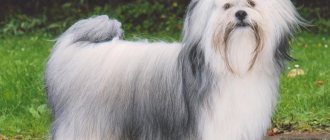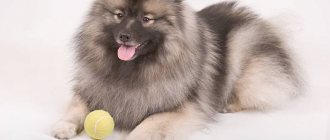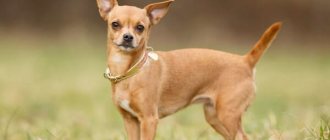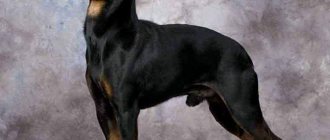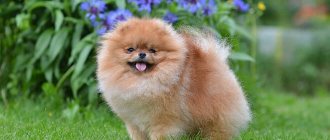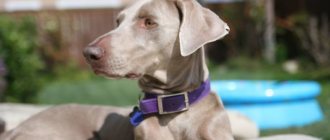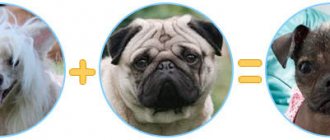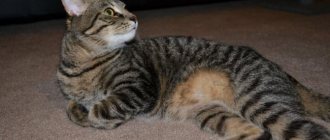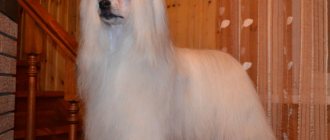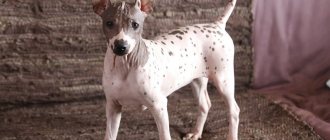/ Dogs / Dog breeds / Arabian Greyhound dog breed
0
1982
Article rating
The Arabian greyhound, or slugi, is a real aristocrat among dogs. In addition, this subspecies is considered extremely rare.
The peculiarity of the Arabian dog breed is that the Slugi can track the victim only with the help of its eyes. The Arabian Greyhound hunts gazelle, wild boar, hare and even fennec fox. However, despite its excellent hunting qualities, it is considered not the most suitable for training. At the same time, judging by the reviews of the owners, the Arabian greyhound is one of the most loyal breeds, which simply captivates with its colorful appearance.
Arabian greyhound
Historical reference
The Slugi, Arabian Greyhound or Sluggi, is an ancient breed whose history goes back thousands of years. The first mention of greyhounds of the Slugi type dates back to 7000 BC. It is known that dogs of this type were bred and revered in Ancient Egypt. Archaeologists have discovered the remains of mummified greyhounds that are over 3,000 years old.
This is interesting! In Ancient Egypt, greyhounds were buried next to their owners, which indicates the honorable status of the four-legged animals.
The ancestors of all modern greyhounds are considered to be aboriginal hunting dogs from the Far East. Four-legged animals helped people hunt hares, foxes, wolves, jackals and hyenas. For several millennia, greyhounds were actively bred by nomads. Dogs were beneficial to people because they independently caught and killed prey. From its ancestors, the Arabian greyhound inherited the skill of sighted hunting, that is, when working, the dog can only rely on what it sees . Slugs are famous for their keen eyesight.
Servants have always been not just companions, they were considered breadwinners. It is known that even in ancient times, Arabian greyhound puppies were artificially fed. In ancient times, milk and any food was too valuable a resource. The fact that the owners fed orphaned puppies confirms the special attitude towards the breed.
According to one version, the first owners of Arabian greyhounds were Egyptian Bedouins. Slugs were trained to catch up, hold, but not kill prey. By instilling this skill, the Bedouins ensured that the carcass of the prey did not have time to deteriorate under the scorching sun.
The nomads took good care of their breadwinners, which was extremely rare for those times. The dogs regularly received meat for food, or rather, the remains of skinned carcasses. For example, many related breeds of greyhounds today are adapted to digest large amounts of carbohydrates. Most greyhounds at the time of the formation of the breed were fed waste from farms - leftover vegetables and grains.
It is known that Arabian greyhounds were also kept in the palaces of sheikhs. They were actively used for demonstration hunting. It all happened something like this: the sheikh was riding a camel and holding a dog on a leash. A little later, the palace dogs were allowed to actually hunt. Arabian greyhounds were trained to work in tandem with a bird of prey . Such hunting was considered especially skillful and spectacular.
This is interesting! The modern name of the Arabian greyhound comes from the city of Slugi in Tunisia. The official place of origin of the breed is Morocco.
Slugs came to Europe at the end of the 19th century. The breed, distinguished by its exquisite characteristics, was often depicted on the canvases of European artists. The most famous works featuring dogs were those of Augustus Legros.
The fighting in the breed's homeland (Franco-Tunisian War) practically destroyed the Slugi. Today, the number of Arabian greyhounds is critically small. In Europe, dogs are almost never found. Despite the rarity and critical condition of the population, Slugi are officially recognized .
The breed standard was adopted in 1980, and 8 years later it was edited and approved.
Appearance[ | ]
The Slugi's appearance is similar to other Arabian greyhounds - the Saluki and the Azawakh. Due to this similarity and similar name, the Slugi is sometimes confused with the short-haired variety of the Saluki, however, mitochondrial DNA studies have shown that these are different breeds[2][4].
Slugs are high-legged dogs (the elongation index is 0.96[7][9]) with strong bones, muscular, but quite light, graceful and majestic. The head is elongated, wedge-shaped, slightly pointed muzzle with powerful jaws equal in length to the skull. The ears are triangular, hanging, with rounded tips. The eyes are large, oval, dark, a little sad. The neck is slender, gracefully arched, without dewlap. The chest is not wide, with a protruding front part, the stomach is strongly tucked, the back is flat[2][7]. The thin long tail is a continuation of the back, curled at the end into a ring and never rises above the back when moving. It is this tail that serves as an excellent balancer and provides fantastic maneuverability at high speeds. The movements of the slug are reminiscent of the movements of a cheetah, another predator adapted to the rapid pursuit of game in the desert[10].
The skin of the slug is very thin, tightly fitting to the body so that the relief of the skeleton and muscles is revealed. The coat is short, smooth and fine. Such covers have minimal weight and aerodynamic resistance at high speeds, and at the same time contribute to better heat dissipation. There is virtually no hair on the lower chest and belly[10].
The color is all shades of red - from light sand to reddish. Black coloring in the form of a mask, brindle, extensive saddle cloth, or veil is allowed. White spots are not allowed, with the exception of a small white spot on the chest[2][7].
Character and training
Against the backdrop of pronounced grace, representatives of the breed are distinguished by endurance and well-developed hunting skills. The Arabian Greyhound has an aristocratic and very independent character. Representatives of the breed are very active, which must be taken into account before purchasing a puppy.
Important! Slugi needs very active and long walks. It is unacceptable for the breed to live in an apartment.
The Arabian Greyhound is very loyal to its owner. The puppy chooses the leader of the family literally a few hours after arriving at its new home. Despite its affection and unbearable separation, the Arabian Greyhound does its best to hide its sensitivity. The truth is revealed when you try to get another pet or when there is a lack of attention. The Arabian Greyhound becomes very jealous and can intentionally cause damage, for example, chewing personal belongings or making a puddle on the owner's bed.
Slugs are very suspicious and wary by nature. The breed does not show signs of aggression, but they can attack quickly and quickly. Like other sighthounds, the Arabian Hound delivers several deep bites with lightning speed, moving from the limbs to the head of the victim. In everyday life, Slugs are gentle and affectionate, provided that they are not in danger. The breed is not recommended for families with small children, since the toddler may not intentionally harm the dog, and the consequences of such actions are unpredictable.
Important! When separated for a long period of time or changes in ownership, most Arabian Greyhounds experience prolonged stress and may become depressed.
The Arabian Greyhound has a fine mental structure and is prone to empathy. A dog can become irritable if there is a conflict situation in the house. In the first 2–3 years of life, the owner must make every effort to raise an obedient and mentally healthy dog. To achieve this goal, the Arabian Greyhound must be constantly socialized.
Important! The Arabian Greyhound does not tolerate being around other pets well.
Established owners note that Slugs are very independent and their decisions often run counter to those of their owners. The Arabian Greyhound usually obeys only one family member. By the way, representatives of the breeds are prone to escape if they sense potential prey. Even if the dog is well trained, it should not be let off the leash in unfamiliar areas or near the roadway.
Description of the Sluga breed, characteristics
Dogs of this breed are raised by many North African tribes, they are especially valued by nomads who use sluggi as a guard and hunting dog. In Europe and America, these dogs participate in racing and are also valued as decorative family pets.
The character of the servant
Slugs are affectionate, loyal, but rather capricious , independent and proud dogs. They love comfort and cannot stand loneliness , and adapt well to the rules in the house . They become very attached to their owner and have a hard time with a change of owner, but these dogs do not like to show their affection. But they are always ready to protect the people they love.
Dogs of this breed are difficult to train , they obey only those they truly respect, and do not accept punishment. When training servants, you need to be patient; a commanding tone will not give the desired result. The early period of development is of great importance; at this time, communication between the puppy and people is extremely necessary.
Slugs are very active dogs and require serious exercise. These dogs have a strong hunting instinct (they will chase animals running away from them), so when going out for a walk, fasten the dogs on a leash and let them run in a safe place (away from highways).
Slugs are the most distrustful of strangers among greyhounds ; this quality makes them excellent watchdogs; they are very attentive to the safety of their owners. If she liked the guest, she herself will take the first step to make friends and do not like it when people force themselves on them. These greyhounds get along well with children, they are patient and forgiving, but do not like to be pulled . You should not leave a child with a dog of any breed unattended. If the slave is accustomed to the presence of other animals in the house from an early age, there should be no problems with them living together. They get along well with dogs of similar personalities, but can behave aggressively towards an unfamiliar dog on the street.
Sluggi colors
- cream or different shades of sand, often with a dark mask,
- Black and tan color with light markings is also found.
Slugi breed standard
- Standard: FCI slugs No. 188d
- Country of origin: Morocco.
- General appearance and disposition: Slugi is one of the 10 greyhounds that make up the group. Its origin comes from the East; many centuries ago this breed settled in North Africa. These days it is most common in Morocco. In general appearance, this is one of the most purebred dogs due to its gait, thin skin and developed dry muscles. Despite her nobility and pride, she is very affectionate to her master and protects him from dangers. The hunting instinct contributes to long-term performance. Nevertheless, he understands the benefits of comfortable living in an apartment.
- Height: males - 66-72 cm, ideal height 70 cm; females - 61-68 cm, ideal - 65 cm.
- Structure: in males 70 cm tall, the body length should reach 67-68 cm. In females with an ideal height of 65 cm, the body length should reach 62-63 cm.
- Type: unified, short-haired.
- Specialization: rutting hunting.
- Head: elongated in profile, elegant, graceful, but somewhat powerful. When viewed from above, it resembles an elongated triangle. Skull: Forms the widest part, tapering towards the tip of the nose. In profile, the upper part of the skull is flat and quite wide, from ear to ear 12-13 cm, in large dogs 14 cm, but this is quite rare. It is distinctly rounded at the back and symmetrically turned inward on both sides. The eye sockets protrude slightly. The bridge of the nose is barely noticeable. Distinct occipital bone.
- Muzzle: in the shape of an elongated, pointed triangle without hypertrophy, approximately the same length as the skull.
- Mouth: straight from the junction with the skull.
- Nose: the nasal planum is black, somewhat heavy. The tip of the nose is boneless and forms a very slight downward bend.
- Lips: Tender and elastic, fitting well to the lower jaw. The corner of the mouth is as invisible as possible. Normal, strong and regular jaw, similar to forceps.
- Eyes: large, dark, deep-set in the sockets, sometimes slightly covered with slightly slanted eyelids. The look is soft, a little sad, full of nostalgia. With a light color, the eyes are usually amber in color.
- Ears: Set high, drooping, fitting well to the head. Not too big, at the end in the shape of a slightly rounded triangle.
- Neck: long, very slender. In profile, the upper part is slightly curved.
- Body: back short, almost horizontal. Gachas are short, dry, wide and slightly convex. Large-bodied and slanted. The chest is not too wide, barely reaching the elbow. Well developed in depth. The ribs are flat, attached to a long and tucked sternum. The belly and sides are lean.
- Tail: thin, base at the extension of the croup, located below the line of the back. Should reach at least to the hock joint.
- Forelegs: Shoulders elongated and sloping. Strong legs. The forearm is bony and muscular. The wrist and metacarpus are elastic and strong.
- Paw: thin, elongated oval. Many lighter-type slugs develop almost a hare's foot. Claw black or colored.
- Hindquarters: Gachas are flat and muscular. The legs are long and very muscular. The hock joint is strong and well arched. The ankle is strong, without a false claw.
- Jog: walk, trot, gallop.
- Skin: very thin, tight-fitting, without folds or sags.
- Dog's body: very short, smooth-fitting and thin.
- Color: sand, light sand, red sand, gray sand, with tan marks, with or without a black “mask”, with or without a black “collar”.
- Defects: Light eyes.
- The head and structure are somewhat awkward.
- The bridge of the nose is too prominent.
- Bad proportions.
- Bad back line.
- Round ribs. The croup is too sloping, too narrow or small.
- The tail is too thick.
- The abdomen is weakly tucked.
- A rough or tough dog.
- Small white spot on chest.
- leprosy;
Sources:
- https://sobakainfo.ru/slyugi-sluggi-foto-opisanie-porody-xarakter/
- https://usatiki.ru/slyugi/
- https://petstime.ru/article/basendzhi-foto-opisanie-i-harakter-porody
- https://nekusaka.com/porody-sobak-nazvaniya-foto/sobaka-slyugi-arabskaya-borzaya-opisanie-porody-harakteristika-uhod-foto.html
Health
The average lifespan of an Arabian greyhound ranges from 12–16 years . Puppies are naturally in good health, but are not able to resist viruses. To prevent infection, puppies and adult dogs must be vaccinated regularly. Unfortunately, in urban conditions, Slugs rarely live to old age; statistically, most dogs die under the wheels of cars.
Note! Arabian greyhounds are extremely sensitive to anesthetics and many aggressive medications.
The purebred nature and small size of the breed does not allow the identification of breed diseases. Today it is known that Arabian greyhounds have a hereditary tendency to progressive retinal atrophy. The disease is often called night blindness, since the first symptom is a sharp decrease in vision at dusk and in the dark.
To prevent the spread of a breed disease and its exclusion from the breed, both parents are examined before mating. A tendency to progressive retinal atrophy is detected by DNA tests. In stud books, isolated cases of hemophilia are recorded, and this disease is hereditary.
